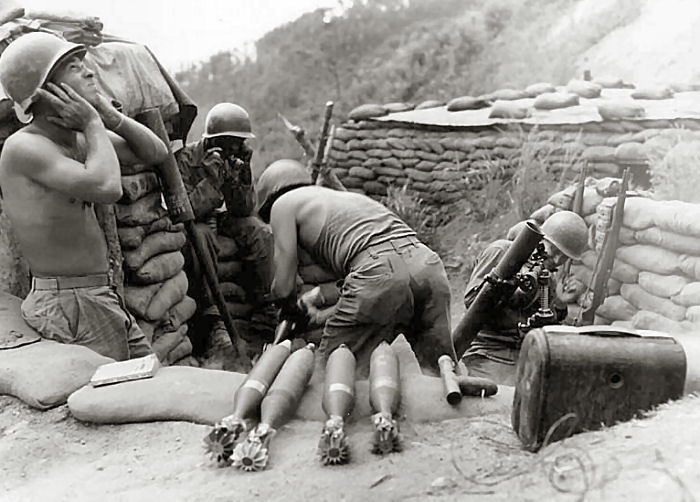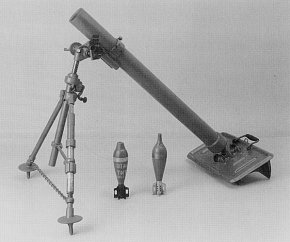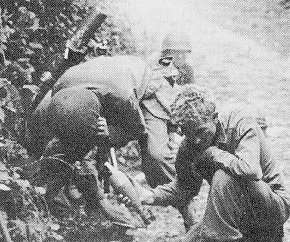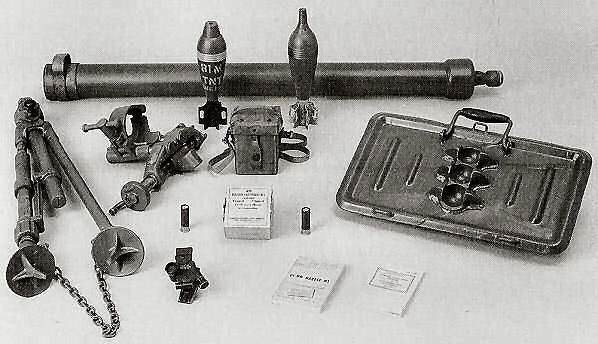General Data
Weight: 136 lbs assembled; tube 44.5 lbs; mount 46.5 lbs; base plate 45 lbs.
Overall Length: 3 ft 9.5 in.
Muzzle velocity (HE): 700 f.p.s.
Rate of Fire: 18 rounds/min norm; 30-35 rpm max
Rocket: M7A1 shaped charge,rocket motor ignited electrically
Maximum Range (HE): 3290 yds
Sight: M4 Ammunition:
M43A1 Light HE: 6.87 lbs; range min 200 yds; range max 3290; 80% frag radius 25 yds (comparing favorably with 75mm howitzer); fast detonating fuse (explode on surface).
M45, M45B1 Heavy HE: 10.62 lbs; range max 2558 yds; bursting radius comparable with 105mm howitzer; equipped with delay fuse so some penetration possible for demolition use.
M56 Heavy HE: 15.01 lbs; range max 1300 yards; adjustable fuse for quick or delay operation.
M57 WP (White Phosphorus): 10.74 lbs; range max 2470 yds; designed to lay down screening smoke, but had definite anti-personnel and incendiary applications.
M57 FS: 10.74 lbs, range max 2470 yds; laid down dense white smoke.
M301 Illuminating shell: range max 2200 yds; attached to parachute; burned brightly (275,000 candlepower) for about 60 seconds, illuminating an area of about 150 yards diameter; used M84 time fuse, adjustable from 5 to 25 seconds before priming charge detonated, releasing the illum and chute.
Each round has fins to stabilize it in flight and cause it to strike fuze-end first. The propelling charge consists of a primer, an ignition cartridge, and (usu) four or six removable propellent increments. The primer and ignition cartridge are inserted in the base of the fin shaft. The removable increments are between the fin blades or the boom assembly. The projectile is dropped down the barrel, fin end first, the primer strikes the fixed firing pin which detonates the primer and ignition cartridge, which in turn ignites the propellent increments, forcing the round out of the barrel, carrying the primer and cartridge with it and readying the mortar for the next round.
Discussion
Comparing weight of material to destruction delivered at the target, mortars are very efficient. 'The infantry's artillery', they provided small infantry units artillery-like fire support when artillery either was not available, or could not be moved forward fast enough. Normally, mortars are fired in defilade, such as from the reverse side of hills or ridges, which gives the gunners protection from direct fire even though close to the enemy. Therefore, the gun squads can be emplaced, and ammunition resupply can be centralized and stockpiled, permitting a heavy volume of fire to be placed on any target within range. This indirect fire relies on Forward Observers, and aiming stakes, and is very effective when done by experienced mortar teams.
The initial Chinese Communist assaults of November and December 1950, did not bring artillery, but they did bring mortars, and used them with great effectiveness. Typical CCF assault tactics were to drift strong infantry units near our lines at night, and use small probing attacks to locate our automatic weapons and machine guns and, if possible, junctions between our platoons or other weak points. Then, they would attack in strength with platoons armed only with grenades, followed by submachine gun platoons. Their light mortar units would follow quickly, and place their fire on our strong points from fairly close distances, enabling them to fire with reasonable accuracy even though at night and without accurate registration.
Our battalion's 81mm mortar platoon, consisting of 6 mortars, were assigned to the battalion's three rifle companies depending on need, and were registered in before nightfall so they could safely respond with appropriate type ammo when called in. This capability, particularly illum rounds, gave our infantry quick support.
Moving the heavy base plate for shifting to new and unregistered targets was often a problem, particularly in the vicious sub-zero cold of North Korea. Getting a stable base plate, for un-registered fire at night, without endangering forward units who needed very close support, was a manual art. With the FO on the communication line, and some strong guy digging new base positions in the frozen earth, it could be done, however, and it was done time and again.
Our 60mm guns, usually in three gun sections in a mortar platoon reinforcing each Rifle Company, were invaluable in closer support. Sometimes in battery, but usually assigned one gun per platoon, they moved fluidly close behind our assault troops, and registered on assault lanes in front of the platoons before night, so as to be ready to quickly counter enemy night assault.
They often had to.





